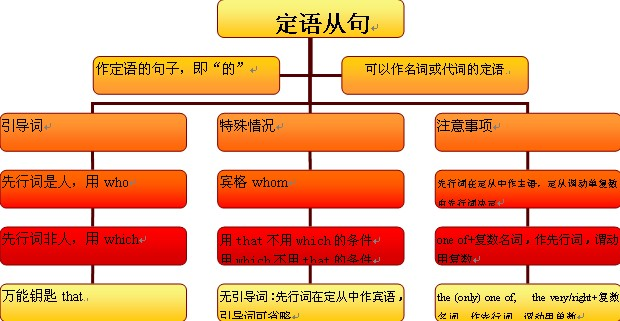本试题 “There are many shows during the Shanghai Expo. Is the UK Pavilion________you want to watch a play?[ ]A. thatB. whereC. whichD. as” 主要考查您对关系副词
限制性定语从句
等考点的理解。关于这些考点您可以点击下面的选项卡查看详细档案。
- 关系副词
- 限制性定语从句
关系副词的概念:
关系副词兼有副词与连接词两种作用,在不及物动词的连接中要求用关系副词。关系副词有when, where, why。
关系副词的特点:
关于副词用于引出定语从句,主要有when, where, why:
如:Sunday is the day when very few people go to work. 星期日是没什么人上班的日子。
That's the reason why he dislikes me. 这就是他不喜欢我的原因。
Do you know a shop where I can find sandals? 你知道哪家商店我能找到凉鞋吗?
注:关系副词用于引出定语从句,且在从句中用作状语。关系副词when表示时间,where表示地点,why表示原因。
使用关系副词应注意的几点:
(1)how不能用作关系副词,不要想当然地将how用作关系副词置于theway后表示方式:他说话就是那个样子。
误:This is the way how he spoke.
正:This is how he spoke./ This is the way(that, in which)he spoke.
(2)关系副词when和where既可引导限制性定语从句,也可引导非限制性定语从句,但why只能引导限制性定语从句,不能引导非限制性定语从句(若引导非限制性定语从句,可用for which reason)。
(3)引导定语从句时,when的先行词为时间,where的先行词为地点,why的先行词为原因(主要是the reason),但是反过来却不一定:
如:Don't forget the time(that) I've toldyou.不要忘记我告诉你的时间。
Do you know the house(that) he bought recently? 你知道他最近买的那座房子吗?
Please tell me there as on(that) you know. 请告诉我你所知道的原因吧。
关系副词的用法:
关系副词有when, where, why,作用有三个:
1、连接主句与从句;
2、代替先行词;
3、在从句中作状语,不可省略。
When和where既可引导限制性定语从句,也可引导非限制性定语从句。Why只能引导限制性定语从句。这些关系副词在意义上都相当于一定得“介词+which”结构。
1)when=at/in/on/during,在定语从句中作时间状语。
例如:Tell me the time when(at which) the train leaves.
注意:
①当表示时间的先行词在从句中中作主语或宾语时,不能用when。
例如:I will never forget the days I spent with your family.
②It/This/That+be+the first/second/last time that…句型中,that是习惯用法,不能用 when代替,that还可以省略。从句中使用与“be动词”呼应的完成形式。
例如:It is the first time that I have been to the Great Wall.
2)where表地点,只能跟在表示地点的名词后,它在定语从句中作地点状语。
例如:This is the second school where I used to teach.
注意:
①引导词where可用that替换,并经常可以省略。
例如:That's the place(where/that) we went before.
②当表示地点的先行词在句中作主语或宾语时,不用where,用关系代词that或which。
例如:The factory that/which we visited yesterday was built last year.
③where可与from连用。
例如:His head soon appeared out of the second story windows, from where he could see nothing but rees.
3)why表原因,引导的从句修饰名词reason。Why可用that或forwhich替换或省略。
例如:I don't know the reason(why/for which/that) he left here.
限制性定语从句的概念:
限制性定语是指对被修饰名词或代词的必需修饰,是被修饰名词或代词不可缺少的修饰语,如果去掉它句子意思往往会不明确或会发生变化。
如:The travellers knowing about the floods took another road. 知道发大水的那些游客改道走了。
The boys wanting to play football were disappointed when it rained. 想踢足球的那些男孩子因为下雨而感到失望。
关系代词引导的定语从句:
关系代词所代替的先行词是人或物的名词或代词,并在句中充当主语、宾语、定语等成分。关系代词在定语从句中作主语时,从句谓语动词的人称和数要和先行词保持一致。
1)who, whom, that 这些词代替的先行词是人的名词或代词,在从句中所起作用如下:
例:Is he the man who/that wants to see you? 他就是你想见的人吗?(who/that在从句中作主语)
He is the man whom/that I saw yesterday. 他就是我昨天见的那个人。(whom/that在从句中作宾语)
2)Whose用来指人或物,(只用作定语,若指物,它还可以同ofwhich互换)
例:They rushed over to help the man whose car had broken down. 那人车坏了,大家都跑过去帮忙。
Please pass me the book whose(of which) coverisgreen. 请递给我那本绿皮的书。
3)which, that 它们所代替的先行词是事物的名词或代词,在从句中可作主语、宾语等。
例如:A prosperity which/that had never been seen before appears in the countryside. 农村出现了前所未有的繁荣。(which/that在句中作宾语)
The package(which/that) you are carrying is about to come unwrapped.你拿的包快散了。(which/that在句中作宾语)
关系副词引导的定语从句:
关系副词可代替的先行词是时间、地点或理由的名词,在从句中作状语。
1)when, where, why 关系副词when, where, why的含义相当于“介词+which”结构,因此常常和“介词+which”结构交替使用。
例如:There are occasions when(on which) one must yield.任何人都有不得不屈服的时候。
Beijing is the place where(inwhich) I was born. 北京是我的出生地。
Is this the reason why(for which) he refused our offer? 这就是他拒绝我们帮助他的理由吗?
2)that代替关系副词 that可以用于表示时间、地点、方式、理由的名词后取代when, where, why和“介词+which”引导的定语从句,在口语中that常被省略,
例如:His father died the year(that/when/in which) he was born. 他父亲在他出生那年逝世了。
He is unlikely to find the place(that/where/in which) he lived forty years ago. 他不大可能找到他四十年前居住过的地方。
限定性定语与非限定性定语的区别:
1、形式不同:
限定性定语从句主句和从句之间不用逗号隔开,口语中使用时也不停顿;而非限定性定语从句与主句之间通常有逗号隔开,口语中使用时有停顿。
2、功能不同:
限定性定语从句用于对先行词的意义进行修饰、限制和识别,如果去掉,就会造成句意不完整或概念不清;而非限定性定语从句用于对先行词起补充说明作用,如果省略,句意仍然清楚、完整:
如:People who take physical exercise live longer. 进行体育锻炼的人活得长些。(若把从句去掉句子就失去意义)
His daughter, who is in Boston now, is coming home next week. 他女儿现在在波士顿,下星期回来。(若把从句去句子意义仍然完整)
3、翻译不同:
在翻译定语从句时,一般把限定性定语从句翻译在它所修饰的先行词之前,而把非限定性定语从句与主句分开:
如:He is the man whose car was stolen. 他就是汽车被窃的那个人。
I've invited Jim, who lives in the next flat. 我邀请了吉姆,他就住在隔壁。
4、含义不同:
如:I have a sister who is a doctor. 我有一个医生的姐姐。(姐姐不止一个)
I have a sister, who is a doctor. 我有一个姐姐,她是当医生的。(只有一个姐姐)
5、先行词不同限定性定语从句的先行词只能是名词或代词,而非限定性定语从句的先行词则可以是名词或代词,也可以是短语或句子;
另外,当先行词为专有名词或其他具有独一无二性的普通名词时,通常要用非限制性定语从句,而不用限制性定语从句:
如:Peter drove too fast, which was dangerous. 彼得开车很快,这是很危险的。(which指drive too fast)
He changed his mind, which made me very angry. 他改变了主意,这使我很生气。(which指整个主句)
Mr.Smith, who is our boss, will leave for Japan next week. 我们的老板史密斯先生下周要去日本。(先行词为专有名词,要用非限制性定语从句修饰)
Her father, who has a lot of money, wishes her to study abroad. 她父亲很有钱,希望她出国学习。(先行词为表独一无二意义的普通名词,要用非限制性定语从句修饰)
6、关系词不同:
关系词that和why可用于限制性定语从句中,通常不用于非限制性定语从句;另外,在限制性定语从句中,关系词有时可以省略,而在非限制性定语从句中关系词一律不省略。
判断关系代词与关系副词方法:
一:用关系代词,还是关系副词完全取决于从句中的谓语动词。及物动词后面无宾语,就必须要求用关系代词;而不及物动词则要求用关系副词。
例如:This is the mountain village where I stayed last year.
I'll never forget the days when I worked together with you.
判断改错
(错)This is the mountain village where I visited last year.
(错)I will never forget the days when I spent in the countryside.
(对)This is the mountain village(which) I visited last year.
(对)I'll never forget the days(which) I spent in the countryside.
注:习惯上总把表地点或时间的名词与关系副词where, when联系在一起。此两题错在关系词的误用上。
二:准确判断先行词在定语从句中的成分(主、谓、宾、定、状),也能正确选择出关系代词/关系副词。
例1. Is this museum ___ you visited a few days age?
A. where
B. that
C. on which
D. the one
例2. Is this the museum ____ the exhibition was held.
A. where
B. that
C.on which
D. the one
答案:例1:D,例2:A
例1变为肯定句:This museum is___ you visited a few days ago.
例2变为肯定句:This is the museum ___ the exhibition was held.
注:在句1中,所缺部分为宾语,而where, that, on which都不能起到宾语的作用,只有the one既做了主句的表语,又可做从句的宾语,可以省略关系代词,所以应选D。
而句2中,主、谓、宾俱全,从句部分为句子的状语表地点,既可用副词where,又因in the museum词组,可用介词in+which引导地点状语。
而此题中,介词on用的不对,所以选A。关系词的选择依据在从句中所做的成分,先行词在从句中作主、定、宾语时,选择关系代词(who,whom,that,which,whose);
先行词在从句中做状语时,应选择关系副词(where地点状语,when时间状语,why原因状语)。
定语从句知识体系:

关系代词that的用法:
1)不用that的情况:
a)在引导非限定性定语从句时。
如:(错)The tree, that is four hundred years old, is very famous here.
b)介词后不能用:
如:We depend on the land from which we get our food.
We depend on the land that/which we get our food from.
2)只能用that作为定语从句的关系代词的情况
a)在there be句型中,只用that,不用which。
b)在不定代词,如:anything, nothing, the one, all, much, few, any, little等作先行词时,只用that,不用which。
c)先行词有the only, the very修饰时,只用that。
d)先行词为序数词、数词、形容词最高级时,只用that。.
e)先行词既有人,又有物时。
例:All that is needed is a supply of oil. 所需的只是供油问题。
Finally, the thief handed everything that he had stolen to the police. 那贼最终把偷的全部东西交给了警察。
与“There are many shows during the Shanghai Expo. Is the UK ...”考查相似的试题有:
- It was April 29,2011 ________ Prince William and Kate Middleton walked into the palace hall of thewedding ceremony.[ ...
- I want to know ______the thief was caught on the spot.A.whichB.thatC.whatD.whether
- The organization, _____ goal is mainly to improve women’s position in the workplace, was founded in 1996.A.whoseB.o...
- He gave his daughter some money, ___________ she could buy an English-Chinesse dictionary.A. whichB. about whichC. wi...
- The problem is _______ we can get enough money.. A.thatB.whichC.whetherD.if
- Microblog is a platform ________ people can express their thoughts and communicate with each other by sending posts.A...
- He offered to drive me to the airport, I felt so grateful.A.to whomB.to whichC.for whichD.for whom
- With hundreds of attractions, Beijing is a city _____ makes a lasting impression on itsvisitors.A.whichB.whereC.wh...
- People who seldom do sports or ________ diet is high in fat will put on weight quickly.A.whoB.whoseC.whichD.what
- --- Haven’t you checked the bill? ______ does $53 plus $5 service charge come to $68?--- Oh! I’m sorry, sir. Here is ...